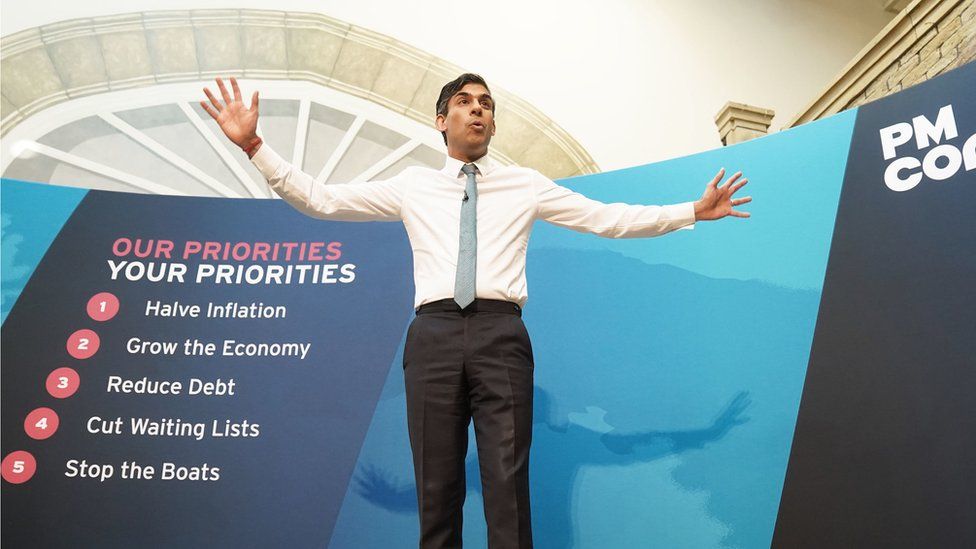
By Anthony Reuben
BBC News
Prime Minister Rishi Sunak set out his five priorities for 2023 in a speech on 4 January.
“I fully expect you to hold my government and I to account on delivering those goals,” he said.
Since then, he and members of his government have repeated them at every opportunity.
So, how is it going after six months?
Halving inflation
The government’s top priority is halving inflation this year.
The measure the government is using is called the Consumer Prices Index (CPI), which tracks changes in the price of a typical basket of goods.
It is aiming to halve inflation of 10.7% – which was the figure for the fourth quarter of 2022 (October to December).
When the pledge was first made, many people expected this to happen anyway.
However, inflation has stayed stubbornly high and was unchanged – at a rate of 8.7% – from April to May. It has not fallen back in recent months in the way that it has in some other big economies.
So, there is still a long way to go to reach the target of 5.3%, and analysts are saying it could go either way.
A big problem for the government is that it mainly relies on the independent Bank of England – over which it has no control – to manage inflation by adjusting interest rates.
When will we know? Inflation figures for the fourth quarter of 2023 will be published on 17 January 2024.
Growing the economy
Downing Street said Mr Sunak’s pledge to “grow the economy” will be met if the economy is bigger in the fourth quarter of 2023 than in the previous three months.
This would not normally be seen as a difficult pledge, because the UK’s economy is usually growing. The economy has got smaller in only four quarters in the past 10 years.
But there has not been a lot of growth recently. In the last four quarters, GDP grew only 0.1% three times and shrunk 0.1% in the other quarter. The UK economy is still smaller than it was before the pandemic.
Another problem for the government is that the pledge to grow the economy is made more difficult by its promise to halve inflation.
The Bank of England has been putting up interest rates in an attempt to stop prices rising so quickly.
The reason behind this is that higher interest rates can reduce the demand for things. However, this slows economic growth.
When will we know? GDP for the fourth quarter of 2023 will be published on 13 February 2024.
Debt falling
When governments talk about debt falling, they almost always mean as a proportion of GDP.
The idea is that debt is falling if it is growing more slowly than the economy.
But that has not been happening recently.
The latest figures show that debt is above 100% of GDP for the first time since 1961.
And if Mr Sunak does not manage to achieve his second priority of growing the economy, then getting debt to fall as a proportion of GDP becomes harder.
It is not clear when Mr Sunak is aiming to have debt falling.
In the Budget in March, the government claimed to be on track because the independent Office for Budget Responsibility – which checks the health of the economy – forecast that debt as a proportion of GDP would fall in 2027-28.
That is in line with the government’s rule that it should be on course for that to happen in five years’ time.
When will we know? The next update on forecasts for debt will accompany government plans for the economy, in its Autumn Statement later this year.
Waiting lists falling
Mr Sunak said: “NHS waiting lists will fall and people will get the care they need more quickly.”
His pledge only refers to waiting lists in England, because Scotland, Wales and Northern Ireland manage their own health systems.
The overall number of patients waiting for treatment in England is still rising – from 7.33 million in March, to 7.42 million in April.
Mr Sunak has claimed that he is cutting waiting lists, but that is only true of certain lists.
The number of people waiting more than 18 months, for example, fell between February and March.
We asked Downing Street when the prime minister aims to have waiting lists falling. It pointed us towards the plan for tackling the backlog of elective care (care planned in advance), which said the overall waiting list was expected to be falling by about March 2024.
When will we know?: Waiting list figures are usually published on the second Thursday of each month.
Stopping small boats
The final priority was to set out a plan to stop the small boats, which are bringing people across the English Channel.
The prime minister proposed to do that by passing a new law. The government’s Illegal Migration Bill has passed through the House of Commons and is now in the House of Lords.
Because the government has a big majority in the House of Commons, the bill is likely to be passed eventually.
Mr Sunak has said that his plan to tackle small boat crossings is “starting to work”.
However, the bulk of arrivals usually turn up in the summer months so we will not know until later in the year whether or not his plan is working.
When will we know? Figures on arrivals in small boats are collected daily.








